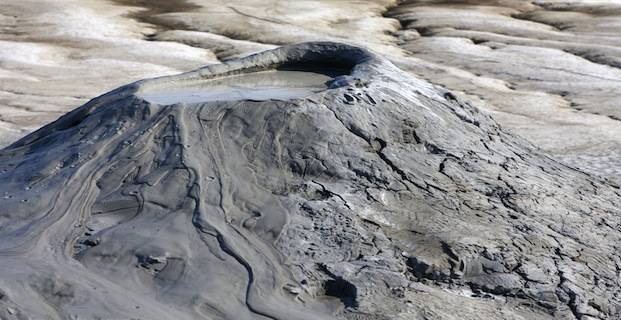Mud Volcano
A mud volcano is a formation that was created by any geo-excreted
gases and liquids and the formation process can vary slightly. This type
of volcano is usually found in subduction zones and around the world,
many have been recognized. Most of the gases that are released from a
mud volcano are methane although they also release much smaller
quantities of nitrogen and carbon dioxide. Generally the ejections from
these volcanoes will be fine solids which are suspended in liquids that
can include acidic water.
These volcanoes have been identified all around the world including
United States, Canada, Taiwan, Italy, Iran, India, Pakistan, Romania,
Burma, China, Indonesia, Japan, Colombia and Venezuela just to name a
few countries. Most, however, appear in Eastern Azerbaijan. Scientists
think there may even be a few on Mars.
Structure
As mentioned earlier, it is more likely to find a mud volcano near a
subduction zone, but they are also common near petroleum deposits. It is
also possible to find them near other types of volcanoes. This type of
volcano has a similar shape to other types of volcanoes and contains
several cones. The gryphon is cone with steep sides that is shorter in
height than 3 meters and will emit mud while the mud cone is less than
10 meters and will emit both rock fragments and mud.
A mud volcano can also contain scoria cones which form when the mud
is heated during fires. In general these volcanoes never grow as large
as other types as the largest have a height of around 700 meters and a
diameter of around 10 kilometers.
Emissions
As mentioned above, when a mud volcano is by itself, the main gas it
emits is usually methane, but in cases when they are located near to
other volcanoes they will usually emit incombustible gases such as
helium instead. Although most of the material is emitted during
eruptions, some seeping can take place even when the volcano is dormant.
Formation
There are several different models for the formation of a mud volcano
but the easiest to understand is the following. The process begins when
decompaction occurs (the opposite of compaction) which will create
gases at a high rate. The gases cause the mud to become buoyant and
because there is more pressure by the mud than there is outside of the
forming mud volcano, the mud leaves the structure via vents or fractures
and takes some of the gas with to relieve the pressure.
Azerbaijan
Azerbaijan has the largest concentration of mud volcanoes with at
least 400, 200 of which are within a range of few thousand square
kilometers. Some of the volcanoes in this area have created islands,
both permanent and temporary, in addition to submarine banks. Some of
the largest of this type of volcano are actually found in Azerbaijan and
are Turaghai and Boyuk Khanizadagh. In 2001, a mud volcano only 15
kilometers from Baku, the capital, erupted, shooting flames that reached
49 feet in the air.
Indonesia
One of the most famous mud volcanoes is Lusi located in Indonesia.
When this mud volcano first showed activity in May of 2006 it killed 14
people and displaced 25,000. Five years after the eruption began, it was
still going on and scientists predicted it would continue for 25 more
years. The volcano has continually spewed mud and gases and as of 2001,
it had already emitted millions of cubic meters of muddy liquids,
reaching an emission up to 180,000 cubic meters of mud per day.
Scientists are unsure what caused the volcano to begin erupting. Some
believe that the previous 6.3 earthquake (which occurred 2 days before
at 280 kilometers away from the site) triggered it while others believe
there was an explosion underground which triggered it.

No comments:
Post a Comment